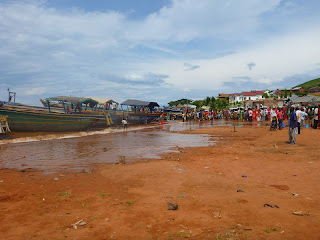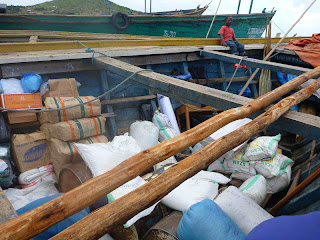To See Our Tanzanian Photos, Click Here
Tanzania is quite a large country, and we found out first hand as we attempted to go from the Island of Zanzibar, through Dar es Salaam and all the way to the Western side of the country and Lake Tanganyika. A trip that ended up taking us 5 days in all. Tanganyika is the longest lake in the world at over 600km, and the second deepest after I believe Lake Baikal in Russia. But this was not the reason for our traipse across country, but rather the tiny little park called Gombe Stream that is home to wild chimpanzees.
 |
| Sipe and Massimo at Sipe's amazing Italian Restaurant |
While in Dar es Salaam, we found out that the train West no longer leaves from Dar, so we had to get ourselves to Dodoma, the start of the Central Train Line. We've done the trek to the bus station before, which always helps for familiarity, so had no problem tackling it again. I must admit, this time was much easier. We had left Mikadi beach at 6AM, and our bus arrived in Dodoma at 4PM - not bad really. We quickly walked to the train station, and found it closed, but we still had time as the train didn't leave until the next evening.
In Dodoma, we found the people to be very friendly and helpful, especially our hotel owner Mr Dayo. The next morning, we got some bad news. After waiting for the ticket office to open, and a few battles with local ladies who decided their needs were greater than ours, and pushing to the front of the line, we found the sleeper compartments for both first class and second class were sold
 |
| Storks in the Rubbish pile |
out. A serious blow, as we were looking forward to the train, even though it was to take 2 full days. And we weren't ready to sit in uncomfortable wooden seats for said two days, especially since they say a lot of robberies can occur. We were resigned to taking the horrible, speedy, dangerous buses, and by this time, we had missed the early ones to Kahama, and decided to spend the day in Dodoma.
This was to turn out very well, since we happened upon a new restaurant, owned by an Italian man Massimo, and his Rwandan wife Sipe. Sipe's Restaurant served up some absolutely amazing Italian food, with the most delicious lasagna I have had in many years!! It was fantastic just to get a change from the local chicken and ugly, rice or chips, but this food was zoo good, we returned for dinner as well. And Sipe made the best home made ice cream - we had the mango. WOW, what a gem.
Massimo was quite the friendly man too, wanting us to see his town. He decided to give us a ride around town to show us the sights, and then dropped us off where the dalla dalla would take us up the hill to the university - Tanzania's biggest.
 |
| Vendors outside the bus near Kigoma |
Not really much to see up here, but a view of the surroundings. We did make it back to Sipe's that night, but I could only manage a half portion of the lasagna, and Michelle only some apple pie and stunning mango ice cream!!
We were sad to not be going back to Sipe's, but our journey must continue. It was an early morning (5AM) departure, so we thought. The bus office was just 100m from our hotel, and we were told to be there at 5. We were, the bus wasn't, so we had to walk through town to the bus station about 1km away. Not too far, but in the dark in Africa isn't the safest. As soon as the bus rushed through the dirt lot of the bus station, we knew we were in for another hair-raising ride. I don't understand why these guys drive these big buses so crazily!! The good news was that we arrived in good time (8 hours), with only a single bus change to Kahama.
At the intersection, we met a really nice lady named Moshi, who got us sorted and onto the next bus.
 |
| Boarding the lake taxis to Gombe Stream |
We asked about a place to stay in Kahama, and when we arrived there, her brother was waiting to meet us. All nice really, but you are never sure what you are going to get when people 'meet' you. They showed us a decent hotel, but after the morning's long walk in the dark, we decided we needed somewhere closer to the station. Kahama was a scruffy little town, and the strangest sight was a garbage/rubbish tip just off the side of the road, with about 15 massive storks walking about looking for scraps. They were intermingled with some dogs, a donkey, and even some people.
Another 6AM departure the next day, and this bus should take us all the way to Kigoma, on the shores of Lake Tanganyika. And you guessed it, another crazy driver, but this time even worse because the road turned quite thin and into dirt. This bus roared around blind corners on the dirt, and just blaring it's horn through villages. Everyone quickly moving over to the side of the road, if not would be turned to dust underneath this beast!!
 |
| This shows the size of the boats, with the little boy up top |
The scenery was fine, but nothing too noteworthy. The colours of the people in the villages was though. It's always interesting as we always see the vendors charging the bus as it pulls to a stop, shoving everything they have high up into the windows in desperation for a sale.
Thankfully, we made it to Kigoma alive, and hoping we don't have to do the return journey. In Kigoma, we could see the massive lake, that felt like we were back at the sea. Only a faint outline of the mountains in the Democratic Republic of Congo across the lake. We managed to get to the Gombe Stream Park Office in town, early in the morning, and by 11AM, we were at the water's edge in Kiribiza, 2 km North of town, awaiting the final leg of our journey - the lake taxi!! These boats are basically wooden rowboats on steroids!!! They seem to be the same design as rowboats, just much larger -
 |
| The next boat - we were in one like this, only fuller |
about 60 feet long. They also seemed relatively organized once we scrambled to get on. They were sorting all the cargo loads into similar village areas, so it would be easy to take it all off in order. You don't see this kind of organization much in Africa, so we were surprised!! Then the rest of the people clamber on…. and it's well over a hundred, and too difficult to count as they are in every nook and cranny of the boat. Our guess was about 130-140. Basically, this lake taxi is the link between all the villages up the lake to the Burundian border. There are no roads, so all goods come by boat as well. It was actually a much more pleasant journey than we were expecting. Other than a bit of rain, we arrived at the dock of Gombe Stream National Park after 3.5 hours on the boat. A long journey overall for sure (5-6 days), so we really hope we find the chimpanzees!!! *Stub



















































